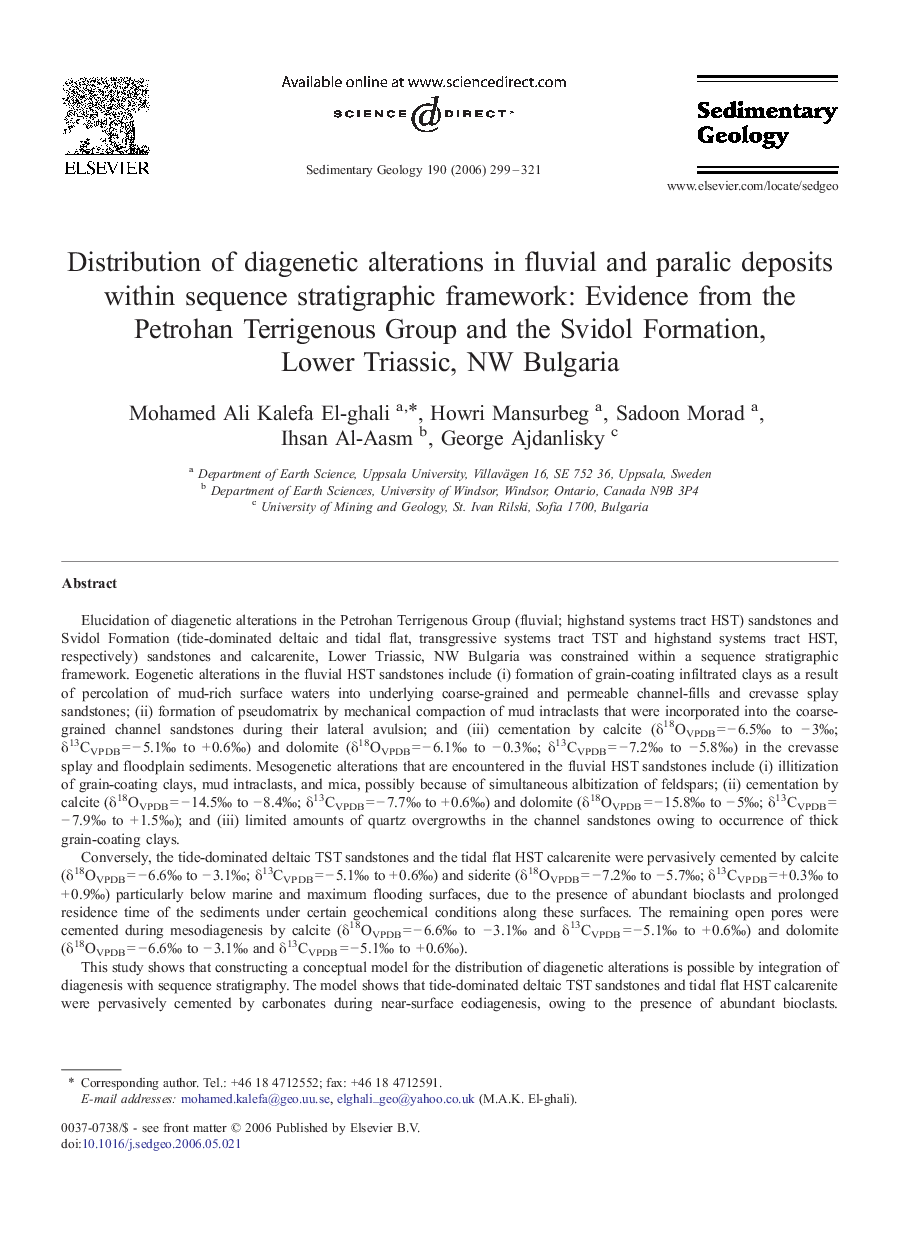| کد مقاله | کد نشریه | سال انتشار | مقاله انگلیسی | نسخه تمام متن |
|---|---|---|---|---|
| 4690980 | 1636183 | 2006 | 23 صفحه PDF | دانلود رایگان |

Elucidation of diagenetic alterations in the Petrohan Terrigenous Group (fluvial; highstand systems tract HST) sandstones and Svidol Formation (tide-dominated deltaic and tidal flat, transgressive systems tract TST and highstand systems tract HST, respectively) sandstones and calcarenite, Lower Triassic, NW Bulgaria was constrained within a sequence stratigraphic framework. Eogenetic alterations in the fluvial HST sandstones include (i) formation of grain-coating infiltrated clays as a result of percolation of mud-rich surface waters into underlying coarse-grained and permeable channel-fills and crevasse splay sandstones; (ii) formation of pseudomatrix by mechanical compaction of mud intraclasts that were incorporated into the coarse-grained channel sandstones during their lateral avulsion; and (iii) cementation by calcite (δ18OVPDB = − 6.5‰ to − 3‰; δ13CVPDB = − 5.1‰ to + 0.6‰) and dolomite (δ18OVPDB = − 6.1‰ to − 0.3‰; δ13CVPDB = − 7.2‰ to − 5.8‰) in the crevasse splay and floodplain sediments. Mesogenetic alterations that are encountered in the fluvial HST sandstones include (i) illitization of grain-coating clays, mud intraclasts, and mica, possibly because of simultaneous albitization of feldspars; (ii) cementation by calcite (δ18OVPDB = − 14.5‰ to − 8.4‰; δ13CVPDB = − 7.7‰ to + 0.6‰) and dolomite (δ18OVPDB = − 15.8‰ to − 5‰; δ13CVPDB = − 7.9‰ to + 1.5‰); and (iii) limited amounts of quartz overgrowths in the channel sandstones owing to occurrence of thick grain-coating clays.Conversely, the tide-dominated deltaic TST sandstones and the tidal flat HST calcarenite were pervasively cemented by calcite (δ18OVPDB = − 6.6‰ to − 3.1‰; δ13CVPDB = − 5.1‰ to + 0.6‰) and siderite (δ18OVPDB = − 7.2‰ to − 5.7‰; δ13CVPDB = + 0.3‰ to + 0.9‰) particularly below marine and maximum flooding surfaces, due to the presence of abundant bioclasts and prolonged residence time of the sediments under certain geochemical conditions along these surfaces. The remaining open pores were cemented during mesodiagenesis by calcite (δ18OVPDB = − 6.6‰ to − 3.1‰ and δ13CVPDB = − 5.1‰ to + 0.6‰) and dolomite (δ18OVPDB = − 6.6‰ to − 3.1‰ and δ13CVPDB = − 5.1‰ to + 0.6‰).This study shows that constructing a conceptual model for the distribution of diagenetic alterations is possible by integration of diagenesis with sequence stratigraphy. The model shows that tide-dominated deltaic TST sandstones and tidal flat HST calcarenite were pervasively cemented by carbonates during near-surface eodiagenesis, owing to the presence of abundant bioclasts. Conversely, fluvial LST sandstones remained poorly cemented during near-surface eodiagenesis due to the lack of bioclasts, but were cemented by mesogenetic calcite, dolomite and quartz overgrowths instead.
Journal: Sedimentary Geology - Volume 190, Issues 1–4, 1 August 2006, Pages 299–321